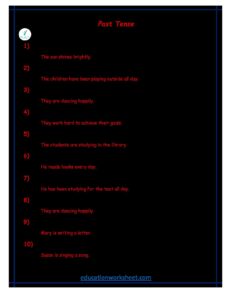how to converting Past Tense negative sentences to positive form
how to converting Past Tense negative sentences to positive form
The English language is a dynamic and versatile tool for communication, and understanding how to manipulate its elements can greatly enhance one’s proficiency. Among the fundamental skills in English grammar is the ability to convert sentences from negative to positive forms. In this guide, we will focus on converting past tense negative sentences into positive ones, offering a comprehensive understanding of the process. Whether you’re a language learner or someone looking to refine their writing and speaking skills, this guide will provide you with valuable insights.
Section 1: Understanding Past Tense Negative Sentences

Before we delve into the process of converting past tense negative sentences into positive ones, it’s essential to grasp the basics of past tense and negative sentence structures.
1.1 Past Tense
Past tense is a verb form used to describe actions, events, or states that have already occurred. In English, regular verbs form the past tense by adding “-ed” to the base form (e.g., “walk” becomes “walked”), while irregular verbs have unique past tense forms (e.g., “go” becomes “went”).
1.2 Negative Sentences

Negative sentences are used to express the opposite of a positive statement. In English, negatives are typically formed by adding the word “not” after the auxiliary verb or using contractions such as “isn’t,” “didn’t,” or “hasn’t.”
Section 2: The Conversion Process
Now that we have a solid foundation, let’s explore the step-by-step process of converting past tense negative sentences into positive ones.
2.1 Identify the Key Elements
The first step in conversion is to identify the essential elements of the negative sentence:
- Subject: Who or what the sentence is about.
- Auxiliary Verb: The helping verb used to form the negative (e.g., “did,” “was,” “had”).
- Main Verb: The action or state being described.
- Negative Marker: The word or contraction indicating negation (e.g., “not,” “didn’t,” “hasn’t”).
2.2 Remove the Negative Marker
The next step is to remove the negative marker from the sentence. If the negative marker is a contraction, expand it into its full form. For example:
Original Negative Sentence: She didn’t go to the party. Positive Sentence (After Removing Negative Marker): She did go to the party.
2.3 Adjust the Auxiliary Verb
In most cases, the auxiliary verb needs to be adjusted to its affirmative form. This often involves changing the tense of the auxiliary verb. For example:
Original Negative Sentence: They weren’t here yesterday. Positive Sentence (After Adjusting Auxiliary Verb): They were here yesterday.
2.4 Ensure Verb Agreement
Ensure that the main verb agrees with the new auxiliary verb in tense and number. If the original negative sentence used an infinitive or base form of the verb, it should be adjusted accordingly:
Original Negative Sentence: He didn’t eat breakfast. Positive Sentence (After Adjusting Main Verb): He ate breakfast.
2.5 Check for Other Modifications
Review the sentence for any other modifications or elements that may need adjustment, such as time expressions, adverbs, or prepositional phrases. Make sure they align with the affirmative form of the sentence:
Original Negative Sentence: We didn’t see them yesterday. Positive Sentence (After Modification): We saw them yesterday.
Section 3: Practice Examples
To solidify your understanding, let’s practice converting a variety of past tense negative sentences into positive ones.
3.1 Example 1:
Original Negative Sentence: I didn’t enjoy the movie. Positive Sentence: I enjoyed the movie.
3.2 Example 2:
Original Negative Sentence: She didn’t visit her grandmother last week. Positive Sentence: She visited her grandmother last week.
3.3 Example 3:
Original Negative Sentence: They didn’t study for the exam. Positive Sentence: They studied for the exam.
3.4 Example 4:
Original Negative Sentence: He didn’t have any coffee this morning. Positive Sentence: He had some coffee this morning.
3.5 Example 5:
Original Negative Sentence: We didn’t play tennis yesterday. Positive Sentence: We played tennis yesterday.
Section 4: Common Pitfalls
Converting past tense negative sentences to positive form may seem straightforward, but there are some common pitfalls to be aware of:
4.1 Verb Agreement
Ensure that the main verb agrees with the new auxiliary verb in both tense and number. Failure to do so can lead to grammatical errors.
4.2 Time Expressions
Be attentive to time expressions and modify them to match the affirmative form of the sentence. This includes adjusting words like “yesterday,” “last week,” or “this morning.”
4.3 Double Negatives
Avoid introducing double negatives in your positive sentences. Double negatives can create confusion and change the intended meaning of the sentence. For example, “I didn’t see nothing” should be corrected to “I didn’t see anything” or “I saw something.”
4.4 Contractions
Ensure that contractions are correctly expanded when converting from negative to positive form. For instance, “wasn’t” becomes “was not” or “didn’t” becomes “did not.”
Section 5: Conclusion
Converting past tense negative sentences into positive form is a valuable skill for English language learners and writers alike. By following the steps outlined in this guide, you can confidently transform negative statements into their positive counterparts while avoiding common pitfalls. Practicing this skill will enhance your overall command of English grammar and communication abilities. Remember that mastering these conversion techniques is not only beneficial but also an enjoyable way to explore the intricacies of the English language.
how to converting Past Tense negative sentences to positive form

how to converting Past Tense negative sentences to positive form Learn how to effortlessly convert negative past tense sentences into positive statements with our easy-to-follow guide. Unlock the power of positive language transformation today


